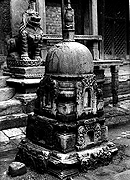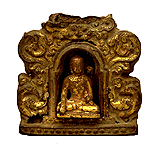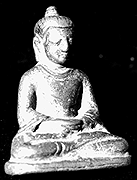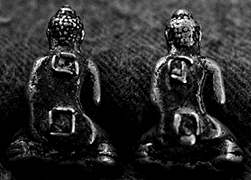|
Comment by Dr. Alexander Rospatt
Licchavi Caityas of Nepal: A Solution to the Empty Niche
Several explanations have been offered for this puzzling detail of these monuments. One is that the figures originally contained in the niches were destroyed during the week-long Muslim incursion led by Sultan Sham ud-din Ilyas of Bengal in 1349. Another, proposed by Ulrich Wiesner in an article on these empty niches, is that the niches were emptied by a single Brahmanical act of religious dominance.1
Wiesner's explanation is supported by the notion, prevalent among Newar Buddhists, that there was a terrible persecution of Buddhists at the time of Shankaracharya. This notion is not supported by concrete historical evidence however, and Nepal's recorded history, while bearing witness to the prevalence of Brahmanical ways among the ruling families, nowhere supports the idea of a single disastrous persecution of the Buddhist community at the hands of radical Hindus.2
Whereas the larger images in the niches of these stupas were designed to be left in situ permanently, the encased Buddha of the Pritzker collection was probably only inserted into the niche at the time of periodic ritual worship, in much the same way that gilt repousse kosas or kavacas (sheaths or coverings) were used to embellish and decorate carved (and, in some cases uncarved and aniconic) deities during special services. When not in use, these portable images were left in the care of the donor or his family, or the guthi or monastery responsible for the worship performed. The practice of creating kosas and kavacas, we might note here, was particularly practiced during the early period; the storehouse of Cangu Narayana contains many superb examples on a Vaisnava theme, and in fact one the earliest and most precious examples of Nepalese repousse work is the kavaca of the Lord of Cangu himself.5 The type of worship involving the periodic embellishment of a stone figure with a portable metal covering or decoration survives in some cases to this day, but does not appear to have survived in the case of the Licchavi caityas. Gods, like dynasties, enjoy ascendance and then suffer from decline, and the Licchavi caityas appear to have been abandoned when the guthis supporting them lapsed and their economic support declined.6 Neglected, their place as objects of worship was taken by later caityas still supported and worshipped by the more recent descendants of the original donor. In most cases later caityas, usually much simpler in design than the sophisticated Licchavi versions, include sculpted stone representations of the Buddhas, evidence that the earlier practice of embellishment with gilt metal had disappeared. The little Pritzker Buddha not only provides us with a quite satisfactory explanation for the empty niches on the Licchavi caityas, but also explains the many tiny Buddhist metal sculptures which form an interesting but little-remarked part of early Nepalese art. Usually of seated or standing figures of the Buddha - but sometimes of bodhisattvas as well - these images are found in many collections and have occasionally appeared in the auction sales. Fig. 5 shows a diminutive figure of the Buddha Amitabha similar in style to the Pritzker Ratnasambhava, but without the repousse surround, while fig. 6 shows a standing Bodhisattva figure that might have been used to fill one of the more elongated niches. Figs. 7 and 8 show later examples of Buddhas that suggest that the practice of supplying metal figures for caitya niches probably survived into later periods, although unknown today.
Send a letter commenting on this article. List of illustrations: Fig. 1 Licchavi caitya, Kathmandu valley, stone, ca. 7-8th century, photograph Mary Slusser to text Fig. 2 Licchavi caitya niche, Cabahil, Kathmandu, stone, ca. 7-8th century; photograph Mary Slusser to text Fig. 3 Licchavi caitya insert, cast and repousse gilt copper, height approx. 4" Pritzker collection, Chicago. to text Fig. 4 Composite photograph of Licchavi caitya insert superimposed on a photograph of a Licchavi caitya. It should be noted that this composite photograph was not assembled with the dimensions of the specific caitya and the figure, and is therefor hypothetical as regards this particular example. However the dimensions of the Pritzker Buddha are entirely consonant with this hypothesis. Note also that, in preparing the composite, the Buddha has been reversed. Caitya photograph courtesy Mary Slusser. Insert Pritzker collection, Chicago. to text Fig. 5 seated Amitabha, gilt copper, Nepal, ca. 7-8th c. Private collection height approx. 2.5" to text Fig. 6 standing Bodhisattva, copper with traces of gilt, Nepal, ca. 7-8th c.; private collection, height approx. 3.5" to text Fig. 7 set of two of the Buddhas, gilt brass, Nepal, ca. 15-17th c., private collection. height approx. 3" to text Fig. 8 set of four figures of the Buddhas, gilt copper, Nepal, ca. 15-17th c., private collection. height approx. 3.5" to text Fig. 9 detail of Fig. 5, side view. Standing Bodhisattva, copper with traces of gilt, Nepal, ca. 7-8th c.; private collection, height approx. 3.5" to text Fig. 10 detail of Fig. 6, rear view showing attachments: set of two of the Buddhas, gilt brass, Nepal, ca. 15-17th c., private collection. height approx. 3" to text Footnotes: 1. Ulrich Wiesner, "Nepalese Votive Stupas of the Licchavi Period: the Empty Niche", in The Stupa, its Religious, Historical and Architectural Significance, edited by A.L. Dallapicolla with S.Z. Lallemant, 1980 Wiesbaden, Franz Steiner Verlag, pp 166 ff. to text 2. Wiesner bases his hypothesis on the testimony of two very late chronicles, and most historians do not accept the testimony of these chronicles regarding this Shankaracharya, who was most probably modelled on the zealous Hindu reformer and philosopher of the 9th century. See Mary Slusser, Nepal Mandala, Princeton, 1982, Princeton University Press, p. 220; Luciano Petech Mediaeval History of Nepal, Rome, 1984, Istituto Italiano per il Medio ed Estremo Oriente, pp 65 and 203. Even the editor of one of the two chronicles cited by Wiesner tends to disbelieve the story: Bikrama Jit Hasrat, History of Nepal, Hoshiapur, 1970, p. 38 ff (p. 39, note 1). to text 3. Mary Slusser in Nepal Mandala, ibid, p. 172, presciently suggests this possibility, while at the same time mentioning Wiesner's hypothesis. to text 4. It should be noted that this composite photograph was not assembled with the dimensions of the specific caitya and the figure, and is therefor hypothetical as regards this particular example. However the dimensions of the Pritzker Buddha are entirely consonant with this hypothesis. Note also that, in preparing the composite, the Buddha has been reversed.to text 5. For the treasures of Cangu Narayana, please see Mohanprasad Khanal, Cangu Narayanaka Aitihasik Samagri, VS 2040, Kathmandu, Centre for Nepal and Asian Studies, Tribhuvan University. to text 6. The guthis (from Skt. goshtha: assembly or meeting) are social and religious organizations that form the backbone of Newar social or religious order. Typically, whenever a major donation to a temple was made, or a new temple or cult established, it was supported by a guthi, whose members where enjoined to support the practice or cult for which the guthi was formed. Major donations often involved the establishment of an endowment, usually in the form of land, income from which supported the activities of the guthi. In the case of individual donations, the family of the donor was responsible for the upkeep of their ancestor's donation; should the family die out or be reduced to poverty, the support would cease. Even major, well-endowed guthis were subject to dissolution and, as was the case in the 19th century, confiscation of their lands by rulers looking for new sources of government funding. to text |








 Often these small figures have prongs or tenons protruding from their backs (see
Often these small figures have prongs or tenons protruding from their backs (see  puzzle as to what these tenons were used for. I for one often conjectured that the diminutive figures may have at one time been part of a larger mandorla or surround of a main image. I am now of the opinion that these figures were once part of the same type of ensemble represented by the Pritzker example. The relatively poor condition of the gilt repousse case surrounding the Ratnasambhava suggests the delicacy of the repousse part of the element, and this delicacy is most likely the reason why we have not found more repousse pieces to fit the myriad small Buddhas and bodhisattvas. In fact it is somewhat a miracle of history that the Pritzker Buddha and his repousse niche have survived the vagaries of some thirteen centuries to guide us to an answer to the riddle of the Licchavi caityas.
puzzle as to what these tenons were used for. I for one often conjectured that the diminutive figures may have at one time been part of a larger mandorla or surround of a main image. I am now of the opinion that these figures were once part of the same type of ensemble represented by the Pritzker example. The relatively poor condition of the gilt repousse case surrounding the Ratnasambhava suggests the delicacy of the repousse part of the element, and this delicacy is most likely the reason why we have not found more repousse pieces to fit the myriad small Buddhas and bodhisattvas. In fact it is somewhat a miracle of history that the Pritzker Buddha and his repousse niche have survived the vagaries of some thirteen centuries to guide us to an answer to the riddle of the Licchavi caityas.